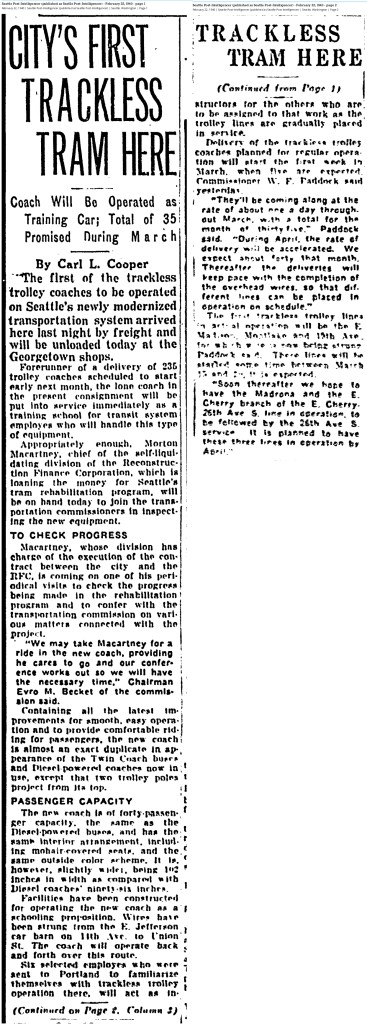(Click and click again to enlarge photos)


Published in The Seattle Times online on Feb. 9, 2023
and in PacificNW Magazine of the printed Times on Feb. 12, 2023
The legacy of Seattle’s streetcar mindset isn’t black-and-white
By Clay Eals

In the beloved “Calvin & Hobbes” comic strip, Calvin asks his dad on Oct. 29, 1989, “How come old photographs are always black and white?” His dad’s classic response: “The world was black and white then.”
The jest underscores how hand-tinted images — like this week’s “Then” photo, circa 1924 — can let the color-habituated among us better envision city life a century ago.
Looking north and slightly east, we hover above East Jefferson Street in an impressive “bird’s eye view” of the Seattle Electric Company’s centrally located, all-wood streetcar barn and yard between 13th and 14th avenues on First Hill.

Erected on former pro-baseball grounds and replacing a barn at Sixth & Olive downtown, the storage and maintenance complex was to have been opened for the 1909 Alaska-Yukon-Pacific Exposition, but its launch came shortly afterward. At its north side, a tower stored water for potential fires while the city completed its fire-hydrant network.

With electrified streetcars continually rolling in and out, the unfenced facility became a busy community landmark, referenced for decades as a locator in classified ads for nearby apartment and room rentals and cafes. It hosted various meetings and even served as a draft-registration site in 1940.
The last Seattle streetcar ran in 1941, but the Jefferson hub operated for 44 years past the city’s rail-to-rubber conversion to trolley coaches. In 1984, the city sold the property to Seattle University, which 10 years later converted it to a soccer stadium, dubbed Championship Field in 1998.

Despite today’s focus on light-rail expansion and getting people out of cars, Seattle’s matrix of now-vanished streetcars produced a higher per-capita use of public transit, notes Mike Bergman, retired Sound Transit and King County Metro planner and author of “Seattle’s Streetcar Era: An Illustrated History, 1884-1941.”
“I think there was more appreciation of the system then,” he says. “The highest levels of ridership occurred during the first and second World Wars, when population densities were far less. Part of it was lower car ownership. Fewer people could afford a car. Fewer still could afford two cars.”
Gradually and relentlessly, he says, automobile and petroleum interests converted the public mindset to individualized travel. “They certainly made it easy to fill up your tank, and it was really cheap,” he says. “It also became a status symbol.”
Bergman optimistically projects another mass-transit heyday, fueled by increased urbanization: “I just don’t think all of those people will be able to get around solely in cars.”
Here we can return to the comic Calvin. In the 1989 strip’s closing panel, he tells his tiger friend Hobbes, “The world is a complicated place.”
WEB EXTRAS
Special thanks to collector Danny Eskenazi , Zachary Tartabull of the Craft Apartments and historians Dave Eskenazi, Bob Carney and Mike Bergman for their invaluable help with this installment!
To see Jean Sherrard‘s 360-degree video of the “Now” prospect and compare it with the “Then” photos, and to hear this column read aloud by Clay, check out our Seattle Now & Then 360 version of the column.
Below are 4 additional photos and, in chronological order, 21 historical clips from The Seattle Times and Seattle Post-Intelligencer online archive (available via Seattle Public Library) and Washington Digital Newspapers, that were helpful in the preparation of this column.




























Thanks for all the great history. It looks as though it really was the wild west back then and now.
Paul always had a saying: “You can pick your nose and you can pick your friends, but you can’t pick your friends nose.” We (Laura Marlow and Gerry Sperry) still say it frequently with much laughter! Ask Paul if he remembers, please.